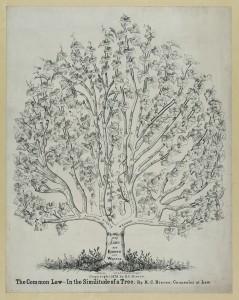Art in the law library: law, legal education and research in the similitude of a tree
 This painting of a tree, by Donna Sciarra, hangs behind the reference desk in the Widener Law Library. In 2000, when the library was remodeled, Eileen Cooper, our library director at the time, had the idea to commission the painting celebrating the roots and future branches of legal education. The inspiration for the tree imagery was a photocopy of an old print, titled “The Common Law in the Similitude of a Tree.” This picture had been found by our archivist, David King, but no one was sure where it had originally come from.
This painting of a tree, by Donna Sciarra, hangs behind the reference desk in the Widener Law Library. In 2000, when the library was remodeled, Eileen Cooper, our library director at the time, had the idea to commission the painting celebrating the roots and future branches of legal education. The inspiration for the tree imagery was a photocopy of an old print, titled “The Common Law in the Similitude of a Tree.” This picture had been found by our archivist, David King, but no one was sure where it had originally come from.
We made efforts to track the origin of the print down, but aside from the title and the copyright notice by “R.C. Bierce, counselor at law,” we had little to go on. We searched reference works, the internet and posted on listservs, but we found no trace of the print or the artist.
 But how quickly things change on the internet. A few months ago I decided to research the print again and quickly found a copy of the print in the Library of Congress Prints and Photographs Collection. It had been originally published in 1878 by Cook & Co. A little more careful searching in Google Books and Google News, led me to the artist, Royal C. Bierce.
But how quickly things change on the internet. A few months ago I decided to research the print again and quickly found a copy of the print in the Library of Congress Prints and Photographs Collection. It had been originally published in 1878 by Cook & Co. A little more careful searching in Google Books and Google News, led me to the artist, Royal C. Bierce.
R.C. Bierce was born in Connecticut in 1808. He moved with his family to Portage County, Ohio where he read law with John Crowell of Warren, Ohio and became a lawyer. Bierce settled in Wisconsin in 1845, teaching school for a few years before establishing a law practice. During the Civil War he served as Colonel of the Bad Ax County, Wisconsin militia. He was the editor of a local newspaper, the Sparta Eagle. R. C. Bierce was also the uncle of the famous writer Ambrose Bierce.
The tree in Bierce’s print illustrates Blackstone’s Commentaries on the Law of England. Like Abraham Lincoln and other lawyers in early America, Bierce “read the law,” serving as a clerk to an established attorney and learning law by reading cases and commentaries on law such as Blackstone or Coke.
The lettering on the base of the tree, “The Objects of the Law are Rights and Wrongs” is from Book 1 chapter 1 of Blackstone.
… the primary and principal objects of the law are rights, and wrongs. In the prosecution therefore of these commentaries, I shall follow this very simple and obvious division; and shall in the first place consider the rights that are commanded, and secondly the wrongs that are forbidden by the laws of England. William Blackstone, Commentaries *122
The divisions of the branches of the tree into topics also follows the outline of Blackstone’s Commentaries. There is a long history of using trees to illustrate legal systems and as an aid to memory. I’ve been unable to discover if this print was meant as an aid in studying Blackstone or was intended as a decorative print for the lawyer’s office, to remind him of his younger days spent reading the law.
This print illustrating the basics of legal education in the 19th century provided the inspiration for the Widener Law library’s painting illustrating the current branches of law and legal education. The growth of the internet and the increased digitization of information allowed me to make the connection between the two.